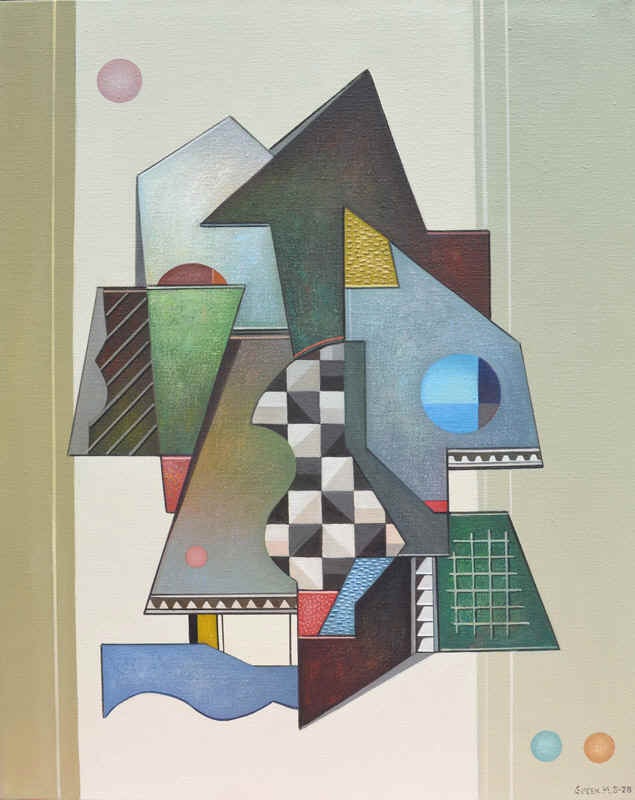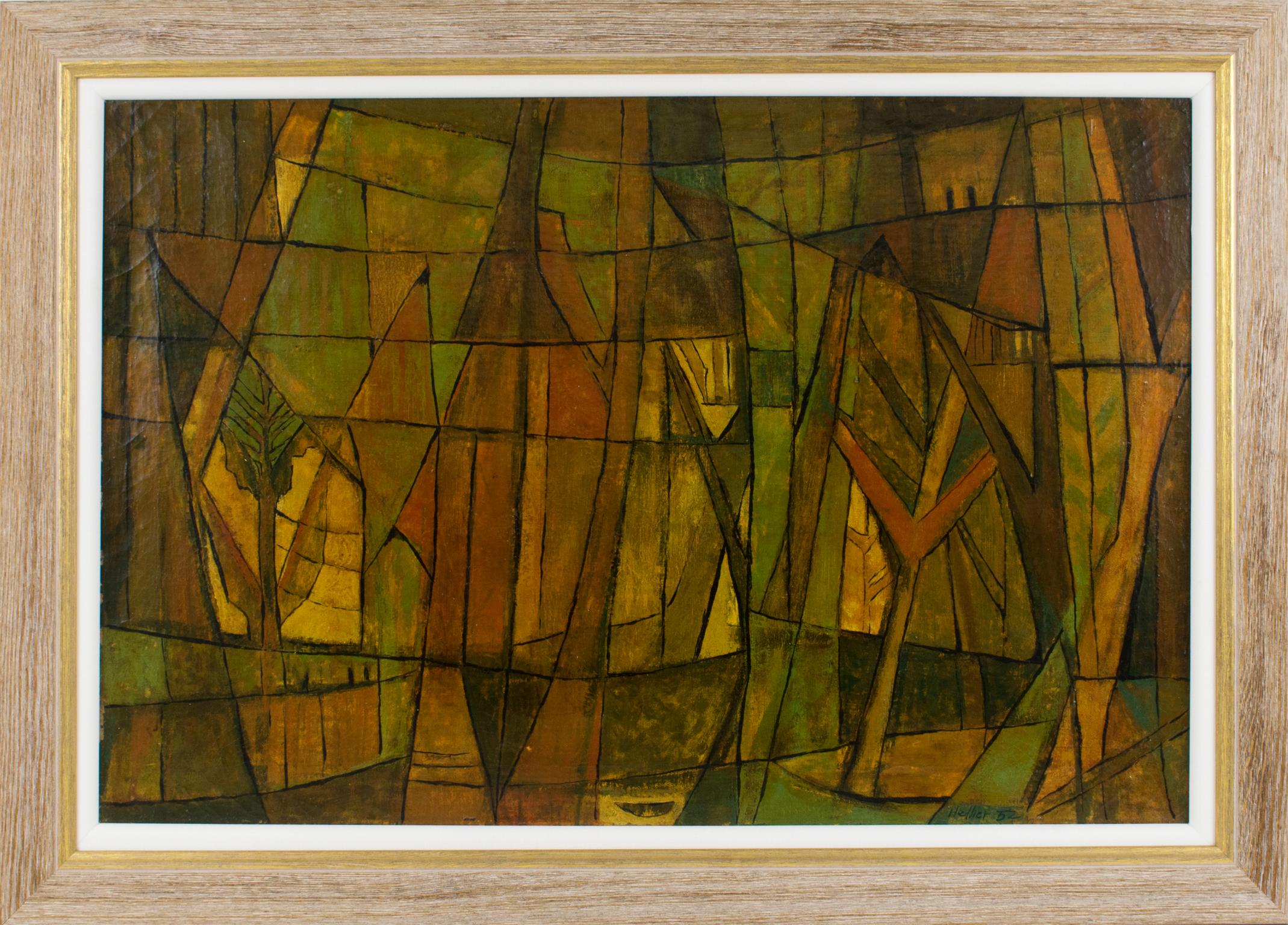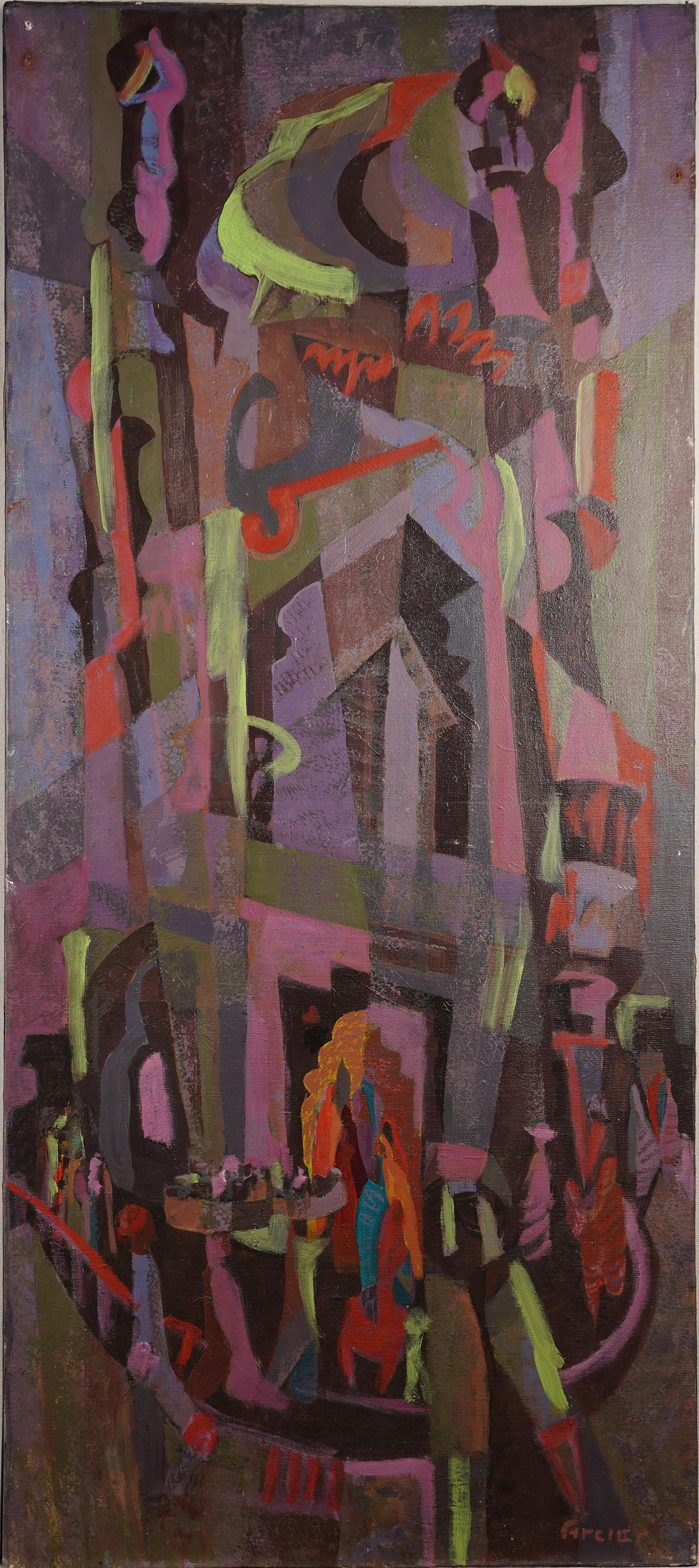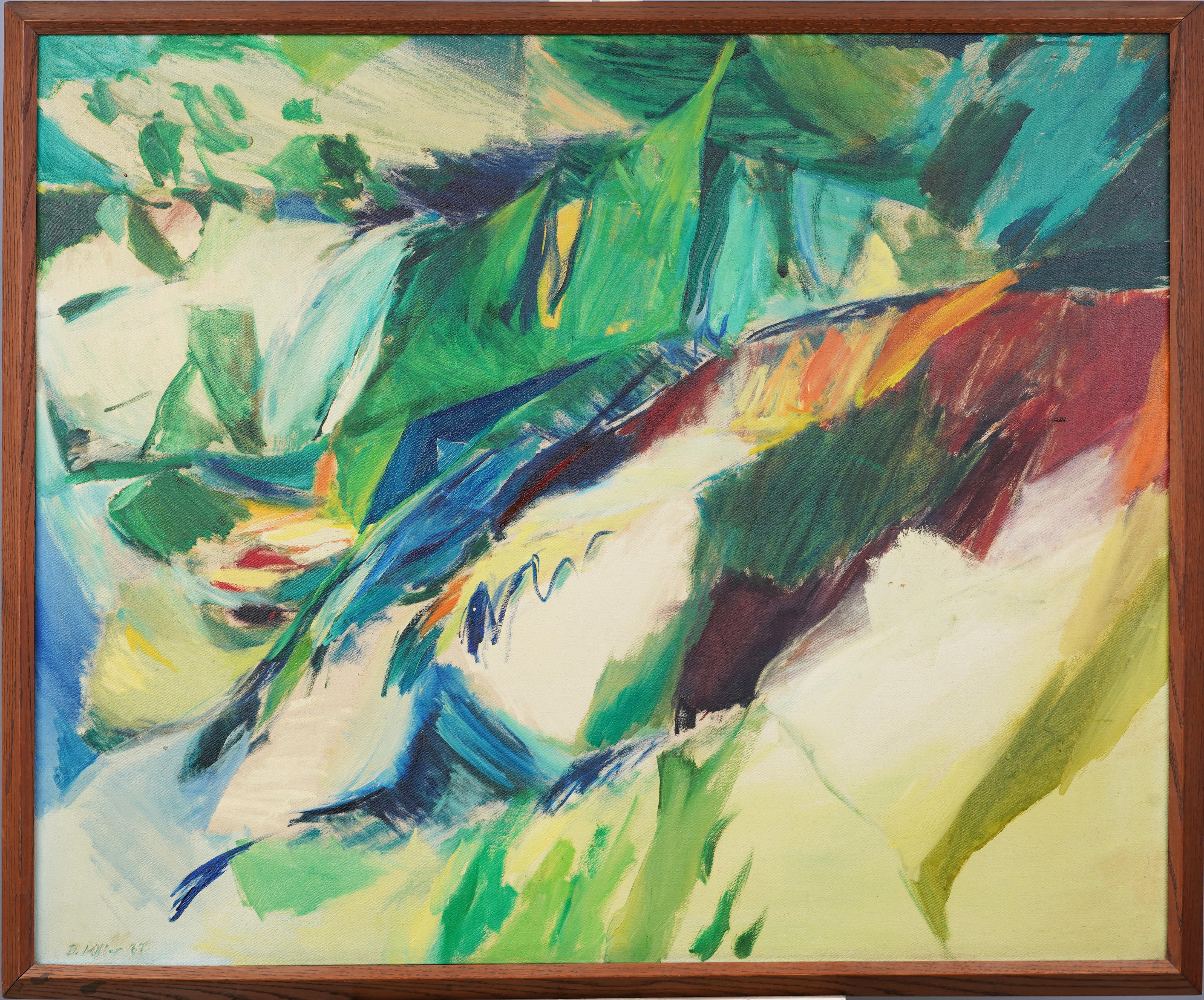Items Similar to A Cubist French City, 1919
Want more images or videos?
Request additional images or videos from the seller
1 of 7
Dick BeerA Cubist French City, 19191919
1919
About the Item
Dick Beer (b. London 1893 - d. Stockholm 1938)
A French City, 1919 (Fransk stad)
oil on canvas
canvas dimensions 82x66 cm
frame 94x78.5 cm
signed Dick Beer
painted 1919
Exhibited:
Gothenburg Art Gallery, Memorial exhibition, 1944;
Åmells Konsthandel – En internationell kubist, Stockholm & London, 2008;
Provenance:
Within the family Beer until today
Cubistic vision:
In the period following the First World War, the artist’s painting underwent a fundamental transformation. Dick Beer was influenced by various modernistic expressions. In Paris, the first wave of cubism, led by Pablo Picasso and Georges Braque, was established. It was a controversial artistic style. There was a heated debate about cubism, in which the artist broke up the motif into smaller components, sometimes called facets, in order to rebuild it on the flat surface of the pictorial plane. This manner of painting represented a complete break with preceding pictorial conventions and naturalistic painting.
Cubism was governed by theory, not practice, and critics claimed that the style was too intellectual for the general public and they predicted that it would disappear and that artists would return to a rather more classic expression.
The theories surrounding cubism and its various expressions opened up for a number of reinterpretations in the 1910s. Dick Beer was well aware of the cubist discussions. He embraced the ideas but created a varied, personal and emotive cubism in the years around 1918. His painting was often an explosive discharge with playful characteristics and a futuristic dynamism which accentuated the painting’s inherent speed and movement, as for example his works “Dancer” and “The Toy Box”. He also experimented with geometric compositions of buildings and landscapes, which were reminiscent of Paul Cézanne’s more cubic landscapes. Here, Beer’s colours were often muted, in blue, brown and red hues. He frequently returned to earlier motifs and reworked his canvases into a cubist style, as in “Dancer tying her shoes” and “Seated dancer“.
Contemporary art critics were appalled and Beer had to endure severe criticism. At one point, the artist published a reply in the daily Politiken, 1919, where he described his view on art:
“... because love for and understanding of art, ‘l’art pour l’art’, is not easy to achieve, and neither is it easy to comprehend the different movements’ or schools’ origin, goals, characteristic endeavours, etc. – These international phenomena require not only theoretical and art historical knowledge but (...) the ability to empathise with and feel for art, as its practitioners do”.
- Creator:Dick Beer (1893 - 1938, Swedish, British)
- Creation Year:1919
- Dimensions:Height: 32.29 in (82 cm)Width: 25.99 in (66 cm)
- Medium:
- Movement & Style:
- Period:
- Condition:Very good, ready to hang.
- Gallery Location:Stockholm, SE
- Reference Number:1stDibs: LU1445212003682
About the Seller
5.0
Platinum Seller
These expertly vetted sellers are 1stDibs' most experienced sellers and are rated highest by our customers.
Established in 2020
1stDibs seller since 2020
117 sales on 1stDibs
Typical response time: <1 hour
Associations
International Confederation of Art and Antique Dealers' Associations
- ShippingRetrieving quote...Ships From: Stockholm, Sweden
- Return PolicyA return for this item may be initiated within 2 days of delivery.
More From This SellerView All
- Cubist Painting By Swedish Artist Dick Beer, View From a Window, 1920Located in Stockholm, SEDick Beer (b. London 1893 - d. Stockholm 1938) Utsikt från fönster, View From a Window, 1920 oil on canvas 73 x 60.5 cm stamp signed painted 1920 Exhibi...Category
1920s Cubist Abstract Paintings
MaterialsCanvas, Oil
- Cubist Painting from 1918-19, Portrait of Dr Mens IIILocated in Stockholm, SEDick Beer (b. London 1893 - d. Stockholm 1938) Portrait of Dr Mens III, 1918-1919 oil on board 70 x 50 cm stamp signed painted c. 1918-1919 Provenance: Within the family Beer until today Dick Beer (1893-1938) Dick Beer was born in London in 1893. His father, John Beer (1853-1906), was a Swedish painter from Stockholm who had a career mainly as a watercolour painter with motifs of horses from racetracks and fox hunts from the countryside. Barely fifteen years old, Dick Beer became an orphan and came to Sweden in 1907. Already in 1908-1909, he started at Althin's painting school in Stockholm. And later, at the Royal Academy of Arts from 1910-1912. His teachers were, among others, Gustaf Cederström, Oscar Björk and Alfred Bergström...Category
1910s Cubist Portrait Paintings
MaterialsOil, Board
- A Wooded Lakeland View, A Landscape Painting by Swedish Artist Carl JohanssonLocated in Stockholm, SECarl Johansson (1863-1944) Sweden A wooded lakeland view oil on canvas signed Carl Johansson painted c. 1940 canvas dimensions 14.96 x 21.85 inches (3...Category
1940s Post-Impressionist Landscape Paintings
MaterialsOil, Canvas
- Shipping in Stormy Waters, Attributed to Italian Artist Francesco GuardiBy Francesco GuardiLocated in Stockholm, SEThe splendour of the tragic sea Francesco Guardi and maritime painting in Venetian art No Venetian painter was a stranger to the sea. After all, Venice was not only one of the most prominent ports of the Mediterranean, but indeed a city literally submerged in the ocean from time to time. Curiously however, the famous Venetian school of painting showed little interest in maritime motifs, favouring scenes from the iconic architecture of the city rather than seascapes. That is why this painting is a particularly interesting window into not only the painter Francesco Guardi himself – but to the significance of the element of water in art history, in absence as well as in the centre of attention. Whether it be calm, sunny days with stunning views of the palaces alongside the canals of Venice or – more rarely – stormy shipwrecking tragedies at sea, water as a unifying element is integral to the works of painter Francesco Guardi (1712–1793). During his lifetime, Venetian art saw many of its greatest triumphs with names like Tiepolo or Canaletto gaining international recognition and firmly establishing Venice as one of the most vibrant artistic communities of Europe. While the city itself already in the 18th century was something of an early tourist spot where aristocrats and high society visited on their grand tour or travels, the artists too contributed to the fame and their work spread the image of Venice as the city of romance and leisure to an international audience, many of whom could never visit in person. Still today, the iconic image of Venice with its whimsical array of palaces, churches and other historic buildings is much influenced by these artists, many of whom have stood the test of time like very well and remain some of the most beloved in all of art history. It was not primarily subtility, intellectual meanings or moral ideals that the Venetian art tried to capture; instead it was the sheer vibrancy of life and the fast-paced city with crumbling palaces and festive people that made this atmosphere so special. Of course, Venice could count painters in most genres among its residents, from portraiture to religious motifs, history painting and much else. Still, it is the Vedutas and views of the city that seems to have etched itself into our memory more than anything else, not least in the tradition of Canaletto who was perhaps the undisputed master of all Venetian painters. Born into his profession, Francesco lived and breathed painting all his life. His father, the painter Domenico Guardi (1678–1716) died when Francesco was just a small child, yet both he and his brothers Niccolò and Gian Antonio continued in their fathers’ footsteps. The Guardi family belonged to the nobility and originated from the mountainous area of Trentino, not far from the Alps. The brothers worked together on more challenging commissions and supported each other in the manner typical of family workshops or networks of artists. Their sister Maria Cecilia married no other than the artist Giovanni Battista Tiepolo himself, linking the family to the most renowned Venetian name of the time. During almost a decade, Guardi worked in the studio of Michele Giovanni Marieschi, sometimes simply known as Michiel, a painted similar in both style and motif. Canaletto is, however, the artist Guardi is most often compared to since they shared a mutual fascination for depicting the architecture and cityscape of Venice. During the course of his career, Guardi tried his hand in many different genres. He was as swift in painting landscapes, Vedutas of Venice, sacred motifs, interiors and architectural compositions as he was in a number of other motifs. His style is typical of the Venetian school but also distinct and personal once we look a little closer. There is an absolute certainty in the composition, the choice of which sometimes feels like that of a carefully calculated photograph – yet it is also very painterly, in the best sense of the word: fluid, bold, sensitive and full of character. The brushwork is rapid, intense, seemingly careless and extraordinarily minute at the same time; fresh and planned in a very enjoyable mixture. His interiors often capture the breath-taking spacious glamour of the palaces and all their exquisite decor. He usually constructed the motif through remarkably simple, almost spontaneous yet intuitively precise strokes and shapes. The result was a festive, high-spirited atmospheric quality, far away from the sterile and exact likeness that other painters fell victim to when trying to copy Canaletto. The painting here has nothing of the city of Venice in it. On the contrary, we seem to be transported far away into the solitary ocean, with no architecture, nothing to hold on to – only the roaring sea and the dangerous cliffs upon which the ships are just moments away from being crushed upon. It is a maritime composition evoking both Flemish and Italian precursors, in the proud tradition of maritime painting that for centuries formed a crucial part of our visual culture. This genre of painting is today curiously overlooked, compared to how esteemed and meaningful it was when our relationship to the sea was far more natural than it is today. When both people and goods travelled by water, and many nations and cities – Venice among them – depended entirely on sea fare, the existential connection to the ocean was much more natural and integrated into the imagination. The schools and traditions of maritime art are as manifold as there are countries connected to the sea, and all reflect the need to process the dangers and wonders of the ocean. It could symbolize opportunity, the exciting prospects of a new countries and adventures, prospering trade, beautiful scenery as well as war and tragedy, loss of life, danger and doom. To say that water is ambivalent in nature is an understatement, and these many layers were something that artists explored in the most wondrous ways. Perhaps it takes a bit more time for the modern eye to identify the different nuances and qualities of historic maritime paintings, they may on first impression seem hard to differentiate from each other. But when allowing these motifs to unfold and tell stories of the sea in both fiction and reality – or somewhere in between – we are awarded with an understanding of how the oceans truly built our world. In Guardi’s interpretation, we see an almost theatrically arranged shipwrecking scene. No less than five ships are depicted right in the moment of utter disaster. Caught in a violent storm, the waves have driven them to a shore of sharp cliffs and if not swallowed by the waves, crushing against the cliffs seems to be the only outcome. The large wooden ships are impressively decorated with elaborate sculpture, and in fact relics already during Guardi’s lifetime. They are in fact typical of Dutch and Flemish 17th century ships, giving us a clue to where he got the inspiration from. Guardi must have seen examples of Flemish maritime art, that made him curious about these particular motifs. One is reminded of Flemish painters like Willem van de Velde and Ludolf Backhuysen, and this very painting has indeed been mistakenly attributed to Matthieu van Plattenberg...Category
18th Century Old Masters Landscape Paintings
MaterialsCanvas, Oil
- View of a Dutch Town by Jan van Couver (Hermanus Koekkoek Jr.) ImpressionismBy Jan Van CouverLocated in Stockholm, SEHermanus Koekkoek the Younger was part of the famous Koekkoek artist family: grandson of Johannes Hermanus Koekkoek, nephew of the landscape painter, Barend Cornelis Koekkoek...Category
Late 19th Century Impressionist Landscape Paintings
MaterialsCanvas, Oil
- Impressionistic Summer Landscape with Road Painted 1889Located in Stockholm, SECarl Johansson's "Summer Landscape with Road" is an exquisite landscape that encapsulates the serene beauty of the Swedish countryside. Painted in 1889, the same year Johansson showcased his work at the Exposition Universelle in Paris, one can't help but wonder if this very painting was among those displayed at the fair. "Summer Landscape with Road" offers a glimpse into the idyllic Swedish countryside through its masterful depiction. The scene is bathed in the distinctive light of the sun positioned at 30 degrees north-northwest, a unique aspect of Johansson's artworks. The viewer's eye is drawn along a winding dirt road that meanders through a tranquil pastoral landscape. Birch trees, with their white bark and tender green leaves, stand tall and sway gently, marking the passage toward a distant homestead nestled beside a calm lake. The rustic wooden fences and the clear sky, dotted with soft, billowing clouds, evoke a sense of peaceful solitude. Johansson's meticulous attention to detail and colour is evident in every brushstroke, from the lush greenery to the soft, earthy path leading to the horizon. The artist's signature use of light not only highlights the natural beauty of the North but also enhances the sense of depth and realism in the painting. Johansson's early works, such as this one, are exceedingly rare, making "Summer Landscape with Road" not only a visual delight but also a collector's gem. The painting's magnificent gold frame enhances the bright, vivid colours of the small-format artwork, creating an impactful presence. Carl Johansson's blue impressionistic depictions of Northern Sweden earned him the nickname "Ultramarine Johansson", and his paintings are celebrated in prestigious collections, including the Nationalmuseum in Stockholm, Kalmar Art Museum, and the municipality of Hudiksvall. oil on canvas signed and dated Carl Johansson . 89 . unframed 27 x 39 cm framed 41,5 x 53 cm Provenance: The previous owner bought it in 1988 at Åmells Stockholm...Category
1880s Impressionist Landscape Paintings
MaterialsCanvas, Oil
You May Also Like
- AscensionBy Maurice GreenLocated in West Hollywood, CAPremiering for the first time in three decades, the original paintings of American artist Maurice Green. Born in 1908 in Latvia, Maurice Green studied with prominent artists of the d...Category
1970s Cubist Abstract Paintings
MaterialsCanvas, Oil
- Post-Cubist Abstract Oil on Canvas Painting by HellierLocated in Atlanta, GAAmerican artist Hellier (20th Century) designed this stunning post-cubist constructivist oil on canvas painting. This painting named "Ste Augustine" features a skillful composition a...Category
1950s Cubist Landscape Paintings
MaterialsCanvas, Oil
- Abstract Cityscape Cubist Oil on Canvas Painting by E. PullmanLocated in Atlanta, GAFrench artist E. Pullman (France, 20th Century) designed this stylish cubist abstract cityscape oil on canvas painting. The skillful composition and rigorous construction use vivid c...Category
Late 20th Century Cubist Landscape Paintings
MaterialsOil, Canvas
- Huge Rare Vintage American School Cubist Abstract Pop Art Abstract Oil PaintingLocated in Buffalo, NYVintage signed large abstract oil painting. Oil on canvas. Signed.Category
1940s Cubist Landscape Paintings
MaterialsCanvas, Oil
- American Impressionist Cityscape Framed Signed Central Park Castle Oil PaintingLocated in Buffalo, NYNicely painted mid century impressionist cityscape oil painting. Great color and composition. Framed. Signed.Category
1960s Cubist Abstract Paintings
MaterialsCanvas, Oil
- Vintage Signed American School Modernist Abstract Cubist Landscape Oil PaintingLocated in Buffalo, NYVery impressive signed 1967 abstract landscape. Appears to be an abstract coastal scene. Framed.Category
1960s Cubist Abstract Paintings
MaterialsCanvas, Oil
Recently Viewed
View AllMore Ways To Browse
Classic French Art
Cubist Artist
Antique Contemporary Art
1919 Painting
Antique Abstract
Cubist Paint
Cubist French Art
Antique Expressions
Cubist Style Art
Oil Painting 1919
Wave City
French Cubist Painting
Cubist Painting France
French Cubism
Cubist Style Paintings
Cubist Works
Framed Cubist Painting
Cubist Painting Framed





